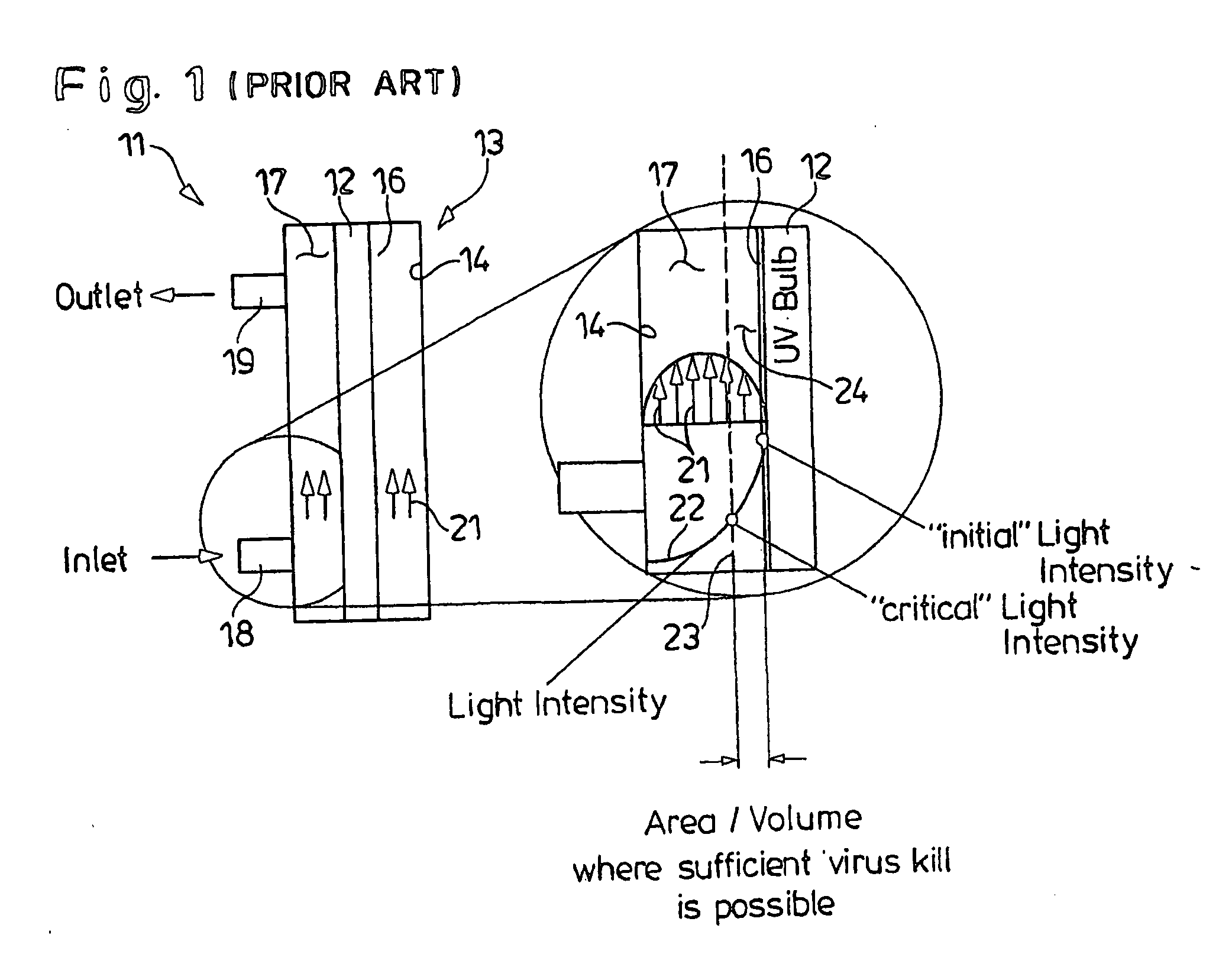Method of inactivating microorganisms in a fluid using ultraviolet radiation
a technology of ultraviolet radiation and inactivation method, applied in chemical/physical/physical-chemical stationary reactors, chemical/physical/physical-chemical processes, energy-based chemical/physical/physical-chemical processes, etc., can solve the problem of affecting the structural and functional integrity of the very proteins, affecting the replication of nucleic acids, and affecting the stability of the fluid
- Summary
- Abstract
- Description
- Claims
- Application Information
AI Technical Summary
Benefits of technology
Problems solved by technology
Method used
Image
Examples
example 1
Critical Parameters in a Process to Inactivate Virus Particles by UV Radiation.
[0072] The goal of viral inactivation by UVC irradiation is to inactivate high levels of virus without damaging the protein or functionality of interest. Two parameters were found to be critical to achieving this goal; namely protein concentration in the fluid, and UV fluency. Fluency is dependent on the physical configuration of the UV irradiator, since internal flow patterns significantly affect the amount of UV light that is received by any given protein molecule or virus panicle in suspension.
[0073] Since proteins absorb in the UV range, high protein concentrations can serve to protect the bulk of the target protein from UVC damage. The high protein concentration, however, will also protect the virus. It is necessary therefore to independently evaluate both protein integrity and viral inactivation at varying protein concentrations, and then to select a concentration of protein for the inactivation ...
example 2
Protein Integrity.
[0080] Following UVC exposure the retention of immunoglobulin integrity was assessed by evaluating the extent of aggregation and fragmentation of the molecule. This was done by size-exclusion HPLC using a TSK-G3000 (Toso-Haas) column and 0.91 M Na2HPO4, pH 5.2-0.2 M NaCl buffer. Immunoglobulin integrity was expressed as the area percent monomeric protein.
[0081] For α1PI, protein integrity was assessed by determining the ability of the enzyme to inhibit porcine elastase. Protein integrity was expressed as the percent of the activity before UVC exposure.
Inactivation of PPV in IGIV.
[0082] Pre-formulation IGIV was diluted to 0.8% with water, adjusted to pH 4.2 and spiked to 10% with PPV. To evaluate the effect of UVC exposure on protein integrity, unspiked IGIV solutions were used. Solutions of IGIV were pumped through a tubular UV reactor with a peristaltic pump, calibrated to deliver 100 ml / min. The protein solution was pumped through the device and re-circulat...
example 3
Inactivation of PPV in Alpha1 Proteinase Inhibitor.
[0083] Alpha1 proteinase inhibitor (α1PI) was diluted to 5 mg / ml in 20 mM Na phosphate, pH 7.0 and 100 mM NaCl and exposed to UVC in the same device as used in example 1. During this experiment, however, the solution was pumped through the device in a single pass at flow rates between 25 and 1200 ml / minutes, resulting in fluencies ranging from 0.19-18 Joules / cm2.
[0084] To evaluate virus reduction, the protein solution was spiked to 10% with PPV and to evaluate protein integrity, unspiked solutions were exposed to UVC. As is also shown in Table 2 at higher fluencies PPV was reduced to a level below that of detection; variation in log reduction was observed due to variation in starting titers of the spiking virus. At least 95% of α1PI activity remained after exposure to fluencies less or equal to 2.3 Joules / cm2.
TABLE 2Fluency (J / cm2)Log10 PPV Reduction% Initial α1PI activity184.276.2n = 1n = 194.8 ± 0.987.6 ± 2.1n = 4n = 44.55.3 ...
PUM
| Property | Measurement | Unit |
|---|---|---|
| wavelength | aaaaa | aaaaa |
| wavelengths | aaaaa | aaaaa |
| wavelengths | aaaaa | aaaaa |
Abstract
Description
Claims
Application Information
 Login to View More
Login to View More - R&D
- Intellectual Property
- Life Sciences
- Materials
- Tech Scout
- Unparalleled Data Quality
- Higher Quality Content
- 60% Fewer Hallucinations
Browse by: Latest US Patents, China's latest patents, Technical Efficacy Thesaurus, Application Domain, Technology Topic, Popular Technical Reports.
© 2025 PatSnap. All rights reserved.Legal|Privacy policy|Modern Slavery Act Transparency Statement|Sitemap|About US| Contact US: help@patsnap.com



